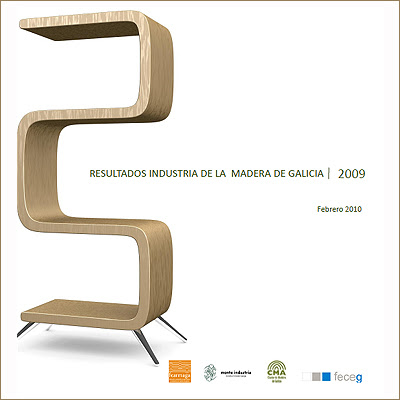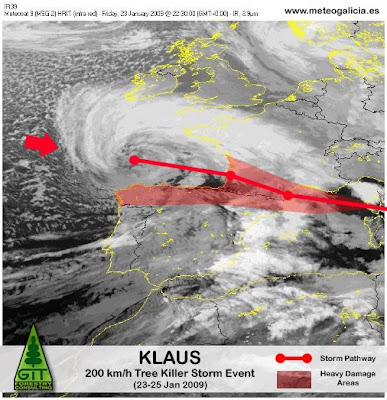Impacts of the Global Crisis on Galician Roundwood Harvests & Timber Industry Productivity
As the worst of the crisis starts to dissipate in the financial markets and optimism messages are spread worldwide to reboost the global economy, we frequently forget that certain productive sectors experience delayed and longer lasting effects than the purely financial. Timber, an always scarce commodity processed to manufacture products you and I use everyday is no exception.

Numbers are grim, but the worst is already over. Recovery is slower than for other industrial sectors, or even for the same forestry sector in other countries, but the storm shall pass. Producing roughly 50% of yearly harvested roundwood in Spain, Galician forestry will survive.
Some Macro-magnitudes
After a historic peak timber harvest record during 2008, delivering over 8 million cubic metres, two events unfolded rapidly during early 2009. By January, Biscay Bay Storm Klaus hit the Eucalyptus & Pine forests of Northern Spain en route to Les Landes d'Aquitaine in Southwestern France. As a consequence, a huge mountain of stormwood was scattered in a very short timespan over Galicia. Non economic harvest of the unexpected stock, carried on as "relief operation" hampered timber harvests during a part of the year and helped push timber prices down. In addition, Klaus stormwood entered the Iberian markets as the French government heavily subsidized the fallen pine wood.
At once, the domino effect of the financial crisis, causing the burst of the "Real Estate and Construction Bubble" in Spain stopped the demand for a varied range of products, from sawn timber for scaffolding, passing by panels and flooring, to furniture and embelishment timbers.
As a result of these and other factors timber industry activity nearly stopped for some product lines, or continued at a daily loss while timber yards were filled and product stocks accumulated.

Fig. 1: Galician Roundwood Harvest, Timber Industry Productivity and Income variations for 2009. (Click image to enlarge)
The consequences, dire. Timber harvests, even including Klaus Stormwood, decreased a 22% compared to 2008. Low timber prices, decreasing industrial demand and stormwood availability paralyzed harvests during the first semester. Industrial productivity fell sharply due to decreased product demand and declining prices, with peak decreases of a 42% for sawmilling lines and 26% for wood panels and board lines compared to 2008. Only Eucalyptus Kraft Pulp productivity kept the levels of the previous year, increasing lightly a 3% thanks to more efficient handling of the industrial process, but global BEKP pulp prices fell sharply diminishing income a 22%.
The overall income of the Galician timber industry for 2009 experienced a decrease for an amount over 500 million € compared to 2008, forcing closure of industrial lines, reduced labour input needs, and the loss of 3,300 jobs.
Download the full report

Also at EUCALYPTOLOGICS...




Want to contact us?

Contact GIT Forestry Consulting - Eucalyptologics

GIT's Eucalyptology Topics
© 2007-2010 Gustavo Iglesias Trabado. Please contact us if you want to use all or part of this text and photography elsewhere. We like to share, but we do not like rudeness.
Click to Read Full Story...
Click to Display Summary only...










 Eucalyptus Online Book & Newsletter
by Celso Foelkel - Celsius Degree
Eucalyptus Online Book & Newsletter
by Celso Foelkel - Celsius Degree
 PinusLetter - By Ester Foelkel - Celsius Degree
PinusLetter - By Ester Foelkel - Celsius Degree
















